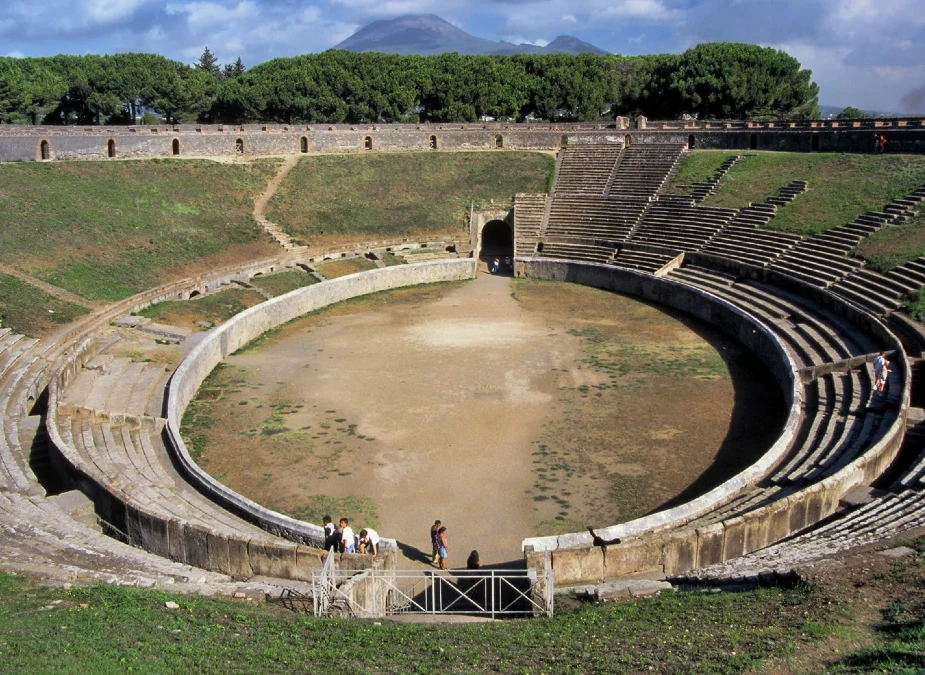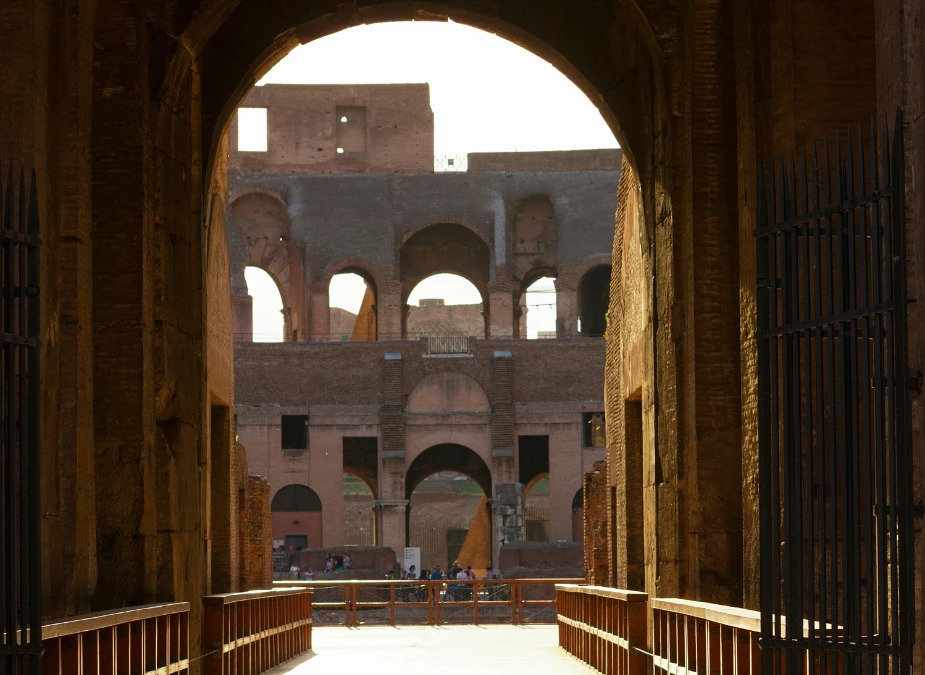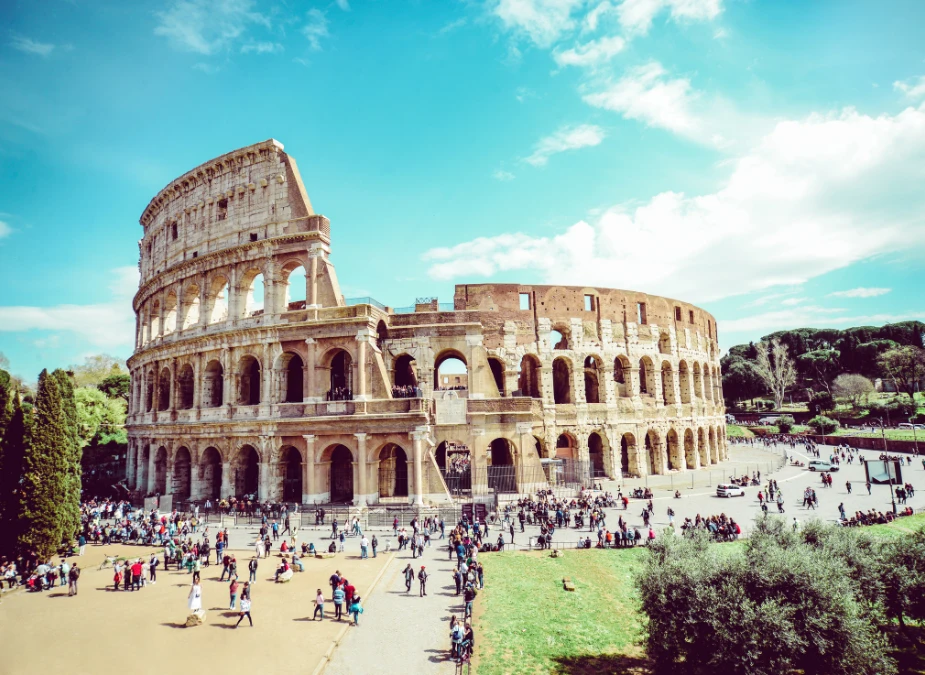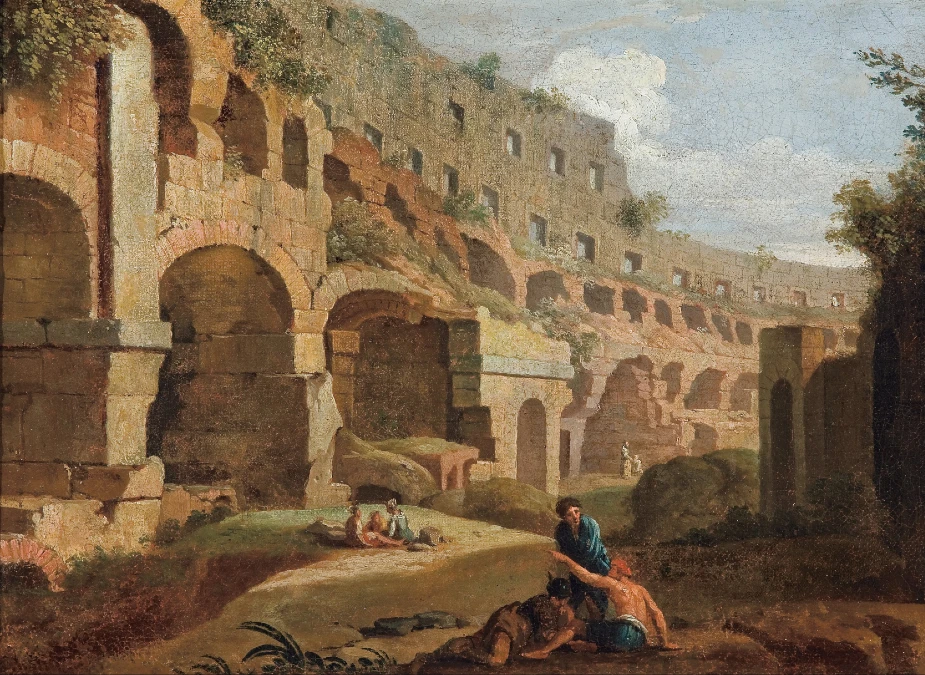The Colosseum’s exterior is one of the most recognizable landmarks in the world. This giant oval structure has stood in Rome for almost 2,000 years and once hosted gladiatorial contests and public spectacles. It draws approximately seven million tourists yearly who marvel at its beautiful facade and historical significance.
In this article, you will examine the exterior of the Colosseum, exploring its design, materials, and some of its unique features.
When visiting the Colosseum’s façade, note the ancient travertine stone’s different textures and colors. These patterns tell stories of its construction and demonstrate the skill of Roman architects and builders.
A Look at the Engineering Marvels
Standing for centuries, the Colosseum’s exterior reveals a fascinating interplay of form and function. Let’s take a look at the arches and their architectural styles:
Shape and Design

Unlike traditional round theaters, the amphitheater was designed in an elliptical shape. This 189-meter-long and 156-meter-wide design allows for better sightlines for spectators in the seating area. Regardless of location within the Colosseum, everyone has a relatively unobstructed view of the central arena.
Innovative Materials
The Romans were masters of material science. The Colosseum’s exterior was primarily constructed from strong and weather-resistant travertine limestone. They also used volcanic ash called tuff for some sections, offering a lighter and more cost-effective alternative. By strategically employing these materials, they achieved structural integrity and economic efficiency.
A Mastery of Weight Distribution
The Colosseum’s massive size presented a significant engineering challenge—how to keep the structure from collapsing under its own weight. The Romans addressed this by cleverly distributing the weight throughout the building.
The outer walls became thicker at the base and eventually tapered upwards. This architectural approach helped shift the weight downward, ensuring stability for years.
A Gallery of Arches
The most recognizable element of the exterior is the series of arches that encircle the building. You will encounter three tiers of arches: the lower Doric arches, the middle Ionic arches, and the upper Corinthian arches.
Each tier showcases distinct architectural styles, reflecting the evolution of Roman craftsmanship over centuries. Beyond their aesthetic appeal, these arches are crucial in providing structural support for the massive building.
Number of Statues
The exterior of the Colosseum once featured numerous statues, but now there are just a few pieces that serve as a remembrance of its former decorations. These statues, primarily depicting gods, emperors, and mythological figures, adorned the arches and niches of the amphitheater’s facade.
The Colosseum’s southern facade was particularly rich in sculptural decoration. It had statues of deities such as Mars and Venus and emperors and heroes. Many of these statues were robbed or destroyed throughout time, leaving only a handful to survive.
The Engineering Feat of Concrete
The Colosseum serves as an ideal example of Roman concrete’s legendary durability. This ingenious mixture of volcanic ash, lime, and water created a strong and versatile material that could be poured into molds, allowing for complex shapes like the vaulted ceilings. This unique substance transformed Roman architecture and continues to astound today.
Entrance Points

Ancient Romans implemented a well-organized system to manage the entry of tens of thousands of spectators, reflecting the social hierarchy of the time. Here are the two types of entry points:
- Grand Entrances: Four elaborate gateways, known as propylaea, were reserved for the elite. These grand entrances provided exclusive access to the emperor, the imperial family, and the Vestal Virgins.
- Public Entrances: 76 smaller entrances facilitated entry for the general public. This efficient design ensured a smooth flow of spectators while maintaining the social order within the Colosseum.
Uncover Colosseum!
Book curated experiences handpicked by our world-trusted partners.
Best Time to View the Exterior

The ideal time to view the exterior of the Colosseum varies based on your preferences. Here’s a guide to help you choose the best time for your visit:
For the best lighting and photo opportunities:
- Sunrise: The golden light of dawn bathes the Colosseum in a warm, ethereal glow. Although the Colosseum may not be open yet, the exterior view is spectacular. After you are done watching the sunrise, grab an early morning Colosseum tour and explore the inside of the monument.
- Late Afternoon (Before Sunset): The afternoon sun casts dramatic shadows on the Colosseum’s facade. Experience this breathtaking moment with a Colosseum sunset tour. Also, aim for an hour or two before sunset to get the best photos.
To avoid crowds:
- Early mornings: Visiting in the early morning, before most tour groups arrive, allows you to experience the Colosseum with fewer crowds.
- Weekdays: Weekends tend to be busier with both tourists and locals. To avoid the crowds, consider planning your visit on a weekday.
For pleasant weather:
- Spring (March-May): Spring offers comfortable temperatures and blooming flowers around the Colosseum, making your visit even more enjoyable.
- Autumn (September-November): Autumn brings pleasant weather and potentially fewer crowds than the peak summer season.
Here’s a secret! Want a different perspective and potentially fewer people? Check out the nearby Parco del Colle Oppio (Oppian Hill). This park offers stunning panoramic views of the monument from above.
The History of the Exterior

The monument’s construction (70-80 AD) began during Emperor Vespasian’s reign and was completed by his son, Titus. The exterior of this grand amphitheater was adorned with three tiers of arches made from white travertine limestone.
A devastating fire in 217 AD significantly damaged the Colosseum’s exterior. Although repairs were undertaken, the pristine white facade was likely never fully restored to its original glory.
With the decline of the Roman Empire in the 5th century AD, the Colosseum’s purpose shifted. The exterior was no longer maintained meticulously and began to weather and deteriorate. It also suffered damage from earthquakes, particularly in 847 AD and 1231 AD, which caused significant parts of the structure to collapse.
During the Middle Ages (6th-14th centuries AD), the Colosseum was repurposed as a fortress. The powerful Roman families, the Frangipane and the Annibaldi fought to control the structure.
The exterior likely underwent significant modifications during this period. Later, during the 17th century onwards, a renewed interest in preserving the Colosseum emerged. Efforts were made to conserve and stabilize the exterior, marking a turning point in the structure’s history. Today, the monument stands as a symbol of Rome’s enduring legacy.
Interesting Facts
- The Colosseum was the largest amphitheater of the Roman Empire and could accommodate around 50,000 to 80,000 spectators.
- Although it appears as a uniform grayish stone today, the Colosseum was once brightly painted. Traces of red, blue, and green pigments have been discovered on the exterior.
- The name ‘Colosseum’ is believed to have originated from the colossal statue of Nero that once stood nearby.
- The outer walls of the Colosseum are made from travertine stone, but they also contain spolia — recycled stone and marble from older structures.
FAQs
1. Why does the Colosseum have different architectural styles on its arches?
The Colosseum features three tiers of arches: Doric at the bottom, Ionic in the middle, and Corinthian at the top. This progression of styles reflects the evolving architectural tastes and advancements during the Roman Empire.
2. What happened to the outside of the Colosseum?
Over the centuries, the Colosseum’s exterior has endured natural disasters like earthquakes and fires. It was also neglected during the fall of the Roman Empire, which caused it to lose its original colors.
3. What are the parts of the Colosseum called?
The Colosseum includes the arena floor, hypogeum (underground area), exterior facade with its arches, interior seating (cavea), and numerous entrances.
4. What color is the outside of the Colosseum?
Today, the exterior is a weathered grayish-white due to travertine stone; originally, it was brightly painted in colors like red, blue, and green, with visible traces.
5. What is the exterior of the Colosseum made of?
The exterior of the Colosseum was primarily constructed from concrete, 3.5 million cubic feet of travertine from Tivoli, and comparable quantities of marble, stone, timber, and volcanic tuff.
Featured Image: David Libeert on Unsplash



